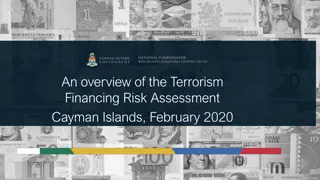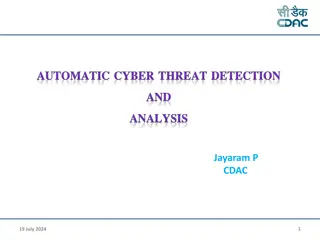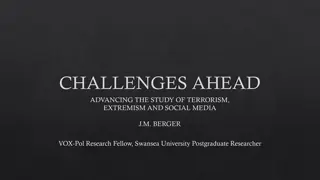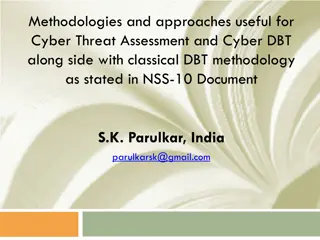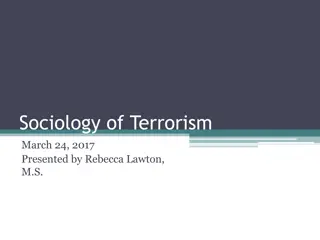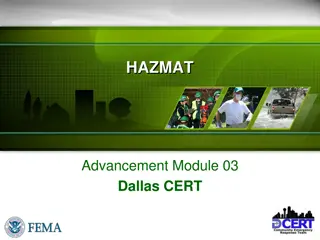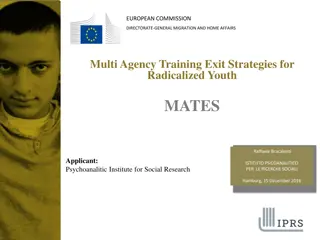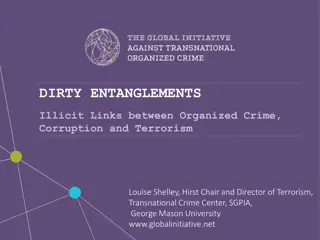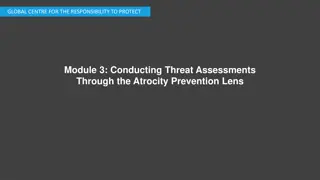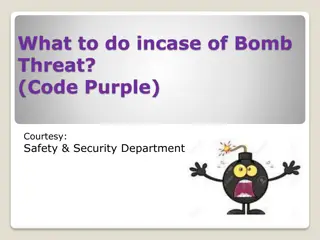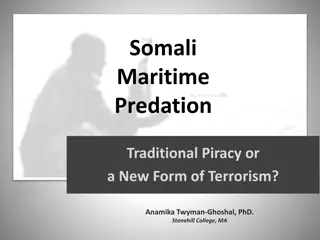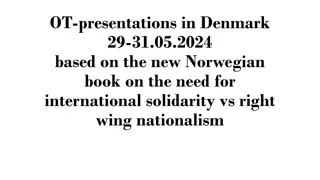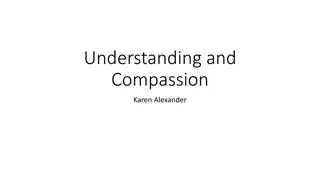Terrorism: A Global Threat in International Politics
The rise of terrorism as a global menace is a significant factor in contemporary international politics. Fueled by advancements in technology and ideology, terrorism poses a formidable challenge, exemplified by events like the 9/11 attacks. Efforts are needed to combat terrorism on both national and international levels, with a focus on marginalized states. Various ideological perspectives contribute to the complex landscape of terrorism, with religiously and ideologically driven groups exhibiting greater reach and influence. The spatial dimension of terrorism has evolved, presenting a complex and far-reaching threat in today's world.
Download Presentation

Please find below an Image/Link to download the presentation.
The content on the website is provided AS IS for your information and personal use only. It may not be sold, licensed, or shared on other websites without obtaining consent from the author. Download presentation by click this link. If you encounter any issues during the download, it is possible that the publisher has removed the file from their server.
E N D
Presentation Transcript
Terrorism: A Global Threat The phenomenal rise of the menace of terrorism is on the centre-stage of international politics, cutting across the boundaries of nation-states which can be reckoned as one of the most formidable factors underpinning the contemporary phase of international politics. Powered by the rapid advancements in the scientific and technological domains, and in conjunction with the ideological intoxications the contemporary incarnation of the cult of terrorism, often branded as super terrorism , has so spectacularly showed its prowess in the form of the 9/11 attacks in 2001 that even the mightier and seemingly invincible nations of the world are finding themselves in precarious and vulnerable situations.
Terrorism(contd.) Huge efforts are required to be concentrated today in the hitherto marginal states in order to help them not only save themselves from the scourge of terrorist violence within their countries but also become a frontal state in the collective endeavour of the international community to take the menace of terrorism head on. As a variant of violent methods of pursuing one s goals in the face of a legitimately established order in a country, terrorism has been in vogue for a fairly long period in the history of modern civilization. But in the new millennium probably the religion based pan- ideological as well as the spatial dimensions have given new orientations to the idea of terrorism which are in manifestation in almost all major terrorist incidents across the world.
Ideological Perspective The ideological perspective of the terrorist activities in recent times may partly be explained by the conceptualizations of Samuel P. Huntington in his clash of civilizations . Ideology, indeed, has been an important driving force behind the conduct of violent activities by terrorists in many countries of the world, as is seen in the cases of the Communist and Maoist inspired blood bath. Yet, the scale and reach of such ideologically motivated violent activities are very limited compared to the scale and reach of the mayhem carried out by the present-day terrorist groups, thereby making them a distinct category in themselves.
Ideological Perspective (contd.) Quite evidently, therefore, the human force and the financial resources available at the disposal of the religion-based and ideology-driven terrorist groups far outweigh the logistical resources of the communist ideology inspired groups, which in turn provide them a sweeping international presence as against the pocketed influence of the latter. For instance, the terrorist groups operating in Kashmir, Chechnya, Palestine, Northern Ireland, etc., were supposedly fighting for their isolated causes without any obvious design to carry forward their strikes to other parts of the world.
Spatial Dimension of Terrorism However, in the current phase of terrorism, such isolated and restrained terrorist operations are increasingly getting integrated with the global network of terrorist organizations, resulting in some sort of concerted and coordinated method of functioning of these organizations and expansion of their spatial functional domain to hitherto unnoticed places like Copenhagen, Bali, London, Karachi, Bangalore, etc. Thus, what the twenty-first century is experiencing by way of terrorist strikes is much more lethal and concerted owing presumably to the transformation of localized terrorism of the past into what may be termed as international terrorism of the present times.
Defining Terrorism: A Contested Domain Keith Shimko talks of three elements of terrorism. First, it involves the threat or use of violence. Secondly, such violence is perpetrated in order to achieve some broader social or political aim. Thirdly, the use of violence is indiscriminate as the basic purpose is to induce far-reaching psychological effects in the minds of the masses (Shimko, 2005: 295).
The Realist Perspective Regarding the issue of legitimacy and monopoly of states to use physical force, the long standing view of the realist school of thought has been that the states not only have the monopoly of using physical force as and when the need arises, their use of force is also legitimate in almost all circumstances. However, the realist argument has been denounced by the critical theorists as subjective rhetoric . By classifying any political violence, including acts of terrorism, as illegitimate in international forums they control, Western states preserve the monopoly on the legitimacy of violence in international system.
Critical Theorists Critique Using relativist arguments, critical theorists suggest that Western states cannot claim moral superiority, and its associated legitimacy, on the basis of their willingness to contravene international norms as it suits them. Thus, the idea of state terrorism or state sponsored terrorism does not remain confined only to the sphere of the developing countries and definitely may be extended to activities of the Western countries as well if they appear to be perpetrating violence either on their own people or on the people of some other countries.
Scholars Supporting Exclusion of State Actors Yet, a number of scholars have argued for the exclusion of state actors from the rubric of terrorism even if their methods of governance are utterly terrifying precisely for the reason of meaningful analysis of the phenomenon. Because not doing so, according to them, would broaden the meaning of terrorism to unmanageable and useless levels.
Conceptualization of Terrorism at Two Levels Finally, the conceptualization of terrorism as a meaningful notion in international relations may take place at two levels: Gandhian formulations and the other when political violence is used as the last resort. At the first level, going by the Gandhian formulations on violence and the idea of non-violence- a value whose universality and timelessness even in international body of politics has been recognized by the United Nations by declaring October 2 as International Day for Non-violence- all forms of violence, whether perpetrated for valid political reasons or otherwise might be branded as terrorism without any rationale in any society.
Conceptualization(contd.) Yet, at the second level, it is argued that when political violence is used in conditions in which no other form of protest is permissible, then it would be wrong to call it violence and in turn terrorism (Hoffman and Graham, 2007: 490). For instance, in India, in the pre-independence days when under the brute force of the British colonial government, legitimate and democratic means of protest were almost absent, the political violence of the Indian revolutionaries would defy the categorization of terrorism.
Causes Behind Terrorism Any discussion on the causation of terrorism must go to analyze the complex factors rooted in political, economic, socio-cultural, religious, ideological, technological and cross- border aspects of a country. Socio-cultural factors also go a long way in consolidating the forces having within themselves the roots of terrorism in the multicultural and multi-ethnic societies.
Causes(contd.) In contemporary times, scholars have also argued that faith-based ideological predilections contribute as one of the most fundamental causes of international terrorism emanating from some Islamic countries of North Africa and Central and South Asia. Drawing on the clash of civilization thesis propounded by Samuel Huntington it is also argued that civilizational conflicts based on competing social and political values are replacing traditional national conflicts as the defining feature of contemporary international politics. The stimuli and nucleus to bring these contradictions in open had been absent earlier.
Causes(contd.) But the adventurist policy of the US along with the advent of personalities like Osama bin Laden with their organizations have afforded both stimulus and nucleus fro these fault lines to come into open, giving birth to what we today refer to as post-modern or new terrorism. In the final analysis, factors behind the rise of terrorism may be more complex than what appear at the hindsight, for, despite the apparent motivations for the initiation of terrorist activities in a region or a country, many subtle simmering discontents might also lie underneath such activities.
Causes(contd.) Indeed, on being marginalized and reduced to a position of perceived subordination by the powerful, terrorism starts breeding in a region to gain some sort of parity with the power holders in the society in terms of psychological, if not material leverages in the society. According to Goldstein, terrorism thus amplifies a small amount of power by its psychological effect on large populations; this is why it is usually a tool of the powerless (Goldstein, 2003: 215). However, what seems to be the new thing in the contemporary phase of international terrorism is the galvanization of the numerous terrorist organizations operating in different parts of the world.
Causes(contd.) Such organizations orient their combined force against their perceived enemies such as countries like United States, Israel, India, Britain, even Pakistan and for that matter any other country which is supposed to be working in an inimical fashion to the interests and considerations of their religion and culture.
International Terrorism in the Twenty- first Century Along with the processes and technologies involved in economic and political globalization of various regions of the world, the menace of international terrorism is set to get new impetus and operational vibrancy in the years to come. Raising the issues involved in the globalization of terrorism, a scholar has succinctly argued that there is little debate that terrorism has become much more pervasive worldwide due to the processes and technologies of globalization. The technological advances associated with globalization have improved the capabilities of terrorist groups to plan and conduct operations with far more devastation and coordination than their predecessors could have ever imagined.
International Terrorism(contd.) In particular, technologies have improved the capabilities of groups and cells in the following areas: proselytizing, coordination, security, mobility and lethality. In the era of globalization, therefore, the character of international terrorism has undergone dramatic transformations with the balance tilting in favour of the terrorist groups, necessitating a concerted and globalized strategy on the part of the societies and states bearing the brunt of terrorism primarily. One of the most obvious results in the advancement of technology has been the refinements in the information technology owing to the fatal conjunction between computers and satellite communication.
Technological Support The technological advancement in terms of unchecked and lightening pace of the flow of information has produced two discernible positive advantages for the monster of international terrorism: i. Firstly, as a major objective of the terrorist groups in conducting surprise and indiscriminate attacks on the people and properties is to gain immense publicity through the media coverage of their strikes. The modern techniques and processes of the transfer of information has come as a great help for the terrorists to get enormous publicity for each and every act of terrorism conducted by them.
Technological Support (contd.) ii. Secondly, the terrorists earlier, had many difficulties to explain the rationale and validity of their cause. They were not only short of resources and public support for their cause but also their point of view was very scarcely transmitted to a wide range of audience so as to garner intellectual and material support for their cause. Such a difficulty has now become almost a thing of the past owing to the easier and accessible methods like the internet and web sites whose recourse has been widely taken by the terrorists to address the targeted audience all over the world and gain subtle moral and material support from their sympathizers.
Tackling International Terrorism Conceptualizing the response to the threat of terrorism Shimko (Shimko, 2005: 299) talks of twofold responses usually found in the world to take on the problem of terrorism: statist response and the cosmopolitan response. The statist response normally views terrorist attacks as acts of war and assumes that the most effective strategy for combating terrorism requires putting pressure on those states that actively or passively support terrorist organizations.
Tackling(contd.) It asserts that along with taking of short term measures based on the calculations and strategies of the security agencies to avoid heavy and devastating losses due to the terrorist activities, the government must make effort to go deeper into the broader issues involved in the rise and growth of terrorism in the particular context. The long term strategy of counter terrorism, according to cosmopolitan strategists, lies in diagnosing the roots of the problem in terms of issues such as poverty, inequality, social divisions and political discontentment amongst the masses. However, the basic difficulty with the cosmopolitan response lies in arriving at a consensus whether the issues mentioned above are the real causes or something else is also relevant.
Tackling(contd.) Notwithstanding the limitation of the international bodies to be an effective instrument of combating terrorism, globalization of the phenomenon of terrorism has inspired the countries to join hands together so as to afford a joint and concerted strategy to track down the movement and striking capabilities of the terrorist groups. In the aftermath of 9/11 the focus of anti-terrorist strategy has shifted from being rooted in national endeavours exclusively to create some sort of international coalition in order to initiate a concerted and coordinated strategy to flush out the terrorist forces from their hideouts.
Concluding Observations However, such a strategy is also marred by the domestic and foreign policy related calculations of various actors in the game. Thus, international terrorism will continue to remain an intractable problem unless countries move beyond their narrow national interests and devise a common strategy to counter terrorism in the larger interest of the humanity.



